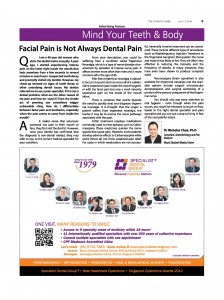 This article first appeared in the July 3rd, 2014 issue of The Straits Times Mind Your Body. We have reproduced it for the information of those of you who missed it when it was published.
This article first appeared in the July 3rd, 2014 issue of The Straits Times Mind Your Body. We have reproduced it for the information of those of you who missed it when it was published.
Q: I am a 48 year old woman who visits the dentist twice annually. A year ago, I started experiencing intense pain on the lower right inside the mouth that lasts anywhere from a few seconds to several minutes or even hours. I suspected tooth decay and promptly visited my dentist. However, my check-up showed no signs of tooth decay or other underlying dental issues. My dentist referred me to see a pain specialist. If it is not a dental problem, what are the other causes of my pain and how do I stop it? Even the simple act of yawning sometimes can sometimes trigger unbearable sting. How do I differentiate between facial pain and toothache, especially when the pain seems to come from inside the mouth?
A: It makes sense that whenever someone has pain in their mouth or face, they first visit the dentist. However, once your dentist has confirmed that the diagnosis is non-dental related, they may refer to you to the correct medical specialist for your condition.
From your description, you could be suffering from a condition called Trigeminal Neuralgia, which is a type of nerve disorder characterized by episodes of intense nerve pain. It affects women more often than men and is more common after the age of 40.
Pain from trigeminal neuralgia is episodic (occurs in spurts) and can occur all of a sudden. Some experience pain inside the mouth together with the facial pain but only a small minority experience pain on the inside of the mouth alone.
There is evidence that points towards the need to quickly treat and diagnose trigeminal neuralgia. It is thought that the longer a patient suffers from trigeminal neuralgia, the harder it may be to reverse the nerve pathways associated with the pain.
Initial treatment employs medications commonly used to treat epilepsy such as Carbamazepine. These medicines quieten the nerve signals that cause pain. However, some patients develop adverse effects to Carbamazepine while some others do not show sustained pain relief. For cases in which medications are not successful, minimally invasive treatment can be considered. These include different types of procedures (such as Radiofrequency Injection Treatment to the Trigeminal Ganglion) that quieten the nerve and make it less likely to fire. They are often very effective in reducing the intensity and the frequency of attacks. In many instances, they have even been shown to produce complete relief.
Neurosurgery (brain operation) is also available for trigeminal neuralgia and the available options include surgical microvascular decompression and surgical sectioning of a portion of the sensory component of the trigeminal nerve.
You should also pay extra attention to oral hygiene – even though when the pain occurs, you might be reluctant to brush or floss. Speak to the right dental specialist and pain specialist and you can put a stop to living in fear of the next painful attack.
Dr. Nicholas Chua, Ph.D
Consultant, Anaesthesiology and Pain Medicine
Mount Elizabeth Medical Centre
Source: © Singapore Press Holdings Limited. Reproduced with permission






